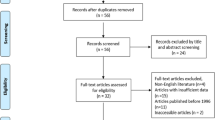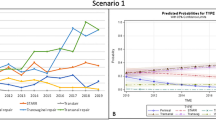Abstract
Background
Internal rectal prolapse and rectocele are frequent clinical findings in patients with obstructed defecation syndrome (ODS). However, there is still no evidence whether stapled transanal rectal resection (STARR) provides a safe and effective surgical option. Therefore, the German STARR registry was initiated to assess safety, effectiveness, and quality of life.
Methods
The German STARR registry was designed as an interventional, prospective, multicenter audit. Primary outcomes include safety (morbidity and adverse events), effectiveness (ODS, symptom severity, and incontinence scores), and quality of life (PAC-QoL and EQ-5D) documented at baseline and at 6 and 12 months. Statistical evaluation was performed by an independent research organization of clinical epidemiology.
Results
Complete data of 379 patients (78% females, mean age 57.8 years) were entered into the registry database. Mean operative time was 40 min, mean hospitalization was 5.5 days. A total of 103 complications and adverse events were reported in 80 patients (21.1%) including staple line complications (minor bleeding, infection, or partial dehiscence; 7.1%), major bleeding (2.9%), and postsurgical stenosis (2.1%). Comparisons of ODS and symptom severity scores (SSS) demonstrated a significant reduction in ODS score between baseline (mean 11.14) and 6 months (mean 6.43), which was maintained at 12 months (mean 6.45), and SSS at preoperative and at 6- and 12-month follow-up (13.02 vs. 7.34 vs. 6.59; paired t test, p < 0.001). Significant reduction in ODS symptoms was matched by an improvement in quality of life as judged by symptom-specific PAC-QoL and generic ED-5Q (utility and visual analog scale) scores and was not associated with an impairment of incontinence score following STARR (p > 0.05). However, 11 patients (2.9%) showed de novo incontinence, and new-onset symptoms of fecal urgency were observed in 25.3% of patients.
Conclusion
These data indicate that STARR is a safe and effective procedure. However, conclusions are limited due to the selection and reporting bias of a registry. The problem of fecal urgency needs cautious reassessment.





Similar content being viewed by others
References
Boccasanta P, Venturi M, Salamina G, Cesana BM, Bernasconi F, Rovario G (2004) New trends in the surgical management of outlet-obstruction: clinical and functional results of two novel transanal stapled techniques from a randomised controlled trial. Int J Colorectal Dis 19:359–369
Schwandner O, Farke S, Bruch HP (2005) Stapled transanal rectal resection (STARR) for obstructed defecation caused by rectocele and rectoanal intussusception. Viszeralchirurgie 40:331–341
Ommer A, Albrecht K, Wenger F, Walz MK (2006) Stapled transanal rectal resection (STARR): a new option in the treatment of obstructive defecation syndrome. Langenbecks Arch Surg 391:32–37
Pescatori M, Dodi G, Salafia C, Zbar AP (2005) Rectovaginal fistula after double-stapled transanal rectotomy (STARR) for obstructed defecation. Int J Colorectal Dis 20:83–85
Dodi G, Pietroletti R, Milito G, Binda G, Pecatori M (2003) Bleeding, incontinence, pain and constipation after STARR transanal double stapling rectotomy for obstructed defecation. Tech Coloproctol 7:148–153
Schwandner O, Fuerst A (2007) German STARR registry. Preliminary results of a prospective, multicenter observational study. Coloproctology 29:13–21
Jayne D, Schwandner O, Stuto A (2009) Stapled transanal rectal resection (STARR) for obstructive defecation syndrome: one-year results of the European STARR registry. Dis Colon Rectum 52:1205–1214
Oliveira J, Pfeiifer J, Wexner SD (1996) Physiological and clinical outcome of anterior sphincteroplasty. Br J Surg 83:502–505
Marquis P, De la Loge C, Dubois D, McDermott A, Chassany O (2005) Develpoment and validation of the patient assessment of constipation quality of life questionnaire. Scand J Gastroenterol 40:540–551
National Institute for Health and Clinical Excellence. Interventional procedure guidance 169: stapled transanal rectal resection for obstructed defaecation. Available at http://www.nice.org.uk
Corman ML, Carriero A, Hager T, Herold A, Jayne DG, Lehur PA, Lomanto D, Longo A, Mellgren A, Nicholls J, Nystrom PO, Senagore AJ, Stuto A, Wexner SD (2006) Consensus conference on the stapled rectal resection resection (STARR) for disordered defaecation. Colorectal Dis 8:98–101
Schwandner O, Stuto A, Jayne D, Lenisa L, Pigot F, Tuech JJ, Scherer R, Nugent K, Corbisier F, Basany EE, Hetzer F (2008) Decision-making algorithm for the STARR procedure in obstructed defecation syndrome: position statement of the group of STARR Pioneers. Surg Innov 15:105–109
Dvorkin LS, Knowles CH, Scott SM, Williams NS, Lunniss PJ (2005) Rectal intussusception: characaterization of symptomatology. Dis Colon Rectum 48:824–831
Zbar AP, Lienemann A, Fritsch H, Beer-Gabel M, Pescatori M (2003) Rectocele: pathogenesis and surgical management. Int J Colorectal Dis 18:369–384
Christiansen J, Zhu BW, Rasmussen OO, Sorensen M (1992) Internal rectal intussusception: results of surgical repair. Dis Colon Rectum 35:1026–1029
Van Tets WF, Kuijpers JHC (1995) Internal rectal intussusception: fact or fancy? Dis Colon Rectum 38:1080–1083
Tsiaoussis J, Chrysos E, Athanasakis E, Pechlivanides G, Tzortzinis A, Zoras O, Xynos E (2005) Rectoanal intussusception: presentation of the disorder and late results of resection rectopexy. Dis Colon Rectum 48:838–844
Von Papen M, Ashari LHS, Lumley JW, Stevenson ARL, Stitz RW (2006) Functional results of laparoscopic resection rectopexy for symptomatic rectal intussusception. Dis Colon Rectum 50:50–55
Sielezneff I, Malouf A, Cesari J, Brunet C, Sarles JC, Sastre B (1999) Selection criteria for internal rectal prolapse repair by Delorme's transrectal excision. Dis Colon Rectum 42:367–373
Abbas SM, Bissett IP, Neill ME, Macmillan AK, Milne D, Parry BR (2005) Long-term results of the anterior Delorme's operation in the management of symptomatic rectocele. Dis Colon Rectum 48:317–322
Benson K, Hartz AJ (2000) A comparison of observational studies and randomized, controlled trials. N Engl J Med 342:1878–1886
Jayne DG, Finan PJ (2005) Stapled transanal rectal resection for obstructed defaecation and evidence-based practice. Br J Surg 92:793–794
Lehur PA, Stuto A, Fantoli M, Villani RD, Queralto M, Lazorthes F, Hershman M, Carriero A, Pigot F, Meurette G, Narisetty P, Villet R, ODS II Study Group (2008) Outcomes of stapled transanal rectal resection vs. biofeedback for the treatment of outlet obstruction associated with rectal intussusception and rectocele: a multicenter, randomized, controlled trial. Dis Colon Rectum 51:1611–1618
Altomare DF, Spazzafumo L, Rinaldi M, Dodi G, Ghiselli R, Piloni V (2008) Set-up and statistical validation of a new scoring system for obstructed defaecation syndrome. Colorectal Dis 10:84–88
Vaizey CJ, Carapeti E, Cahill JA, Kamm MA (1999) Prospective comparison of faecal incontinence grading systems. Gut 44:77–80
Pescatori M, Gagliardi G (2008) Postoperative complications after procedure for prolapsed hemorrhoids (PPH) and stapled transanal rectal resection (STARR) procedures. Tech Coloproctol 12:7–19
Pesactori M, Zbar AP (2009) Reinterventions after complicated or failed STARR procedure. Int J Colorectal Dis 24:87–95
Bruch HP, Fischer F, Schiedeck THK, Schwandner O (2004) Obstructed defecation. Chirurg 75:861–870
Schwandner O, Fürst A (2008) Actual role of stapled transanal rectal resection (STARR) for obstructed defecation syndrome. Zentbl Chir 133:116–122
Schwandner O, Bruch HP (2006) Significance of obstructed defecation in hemorrhoidal disease: results of a prospective study. Coloproctology 28:13–20
Boccasanta P, Venturi M, Rovario G (2007) Stapled transanal rectal resection versus stapled anopexy in the cure of hemorrhoids associated with rectal prolapse. A randomized controlled trial. Int J Colorectal Dis 22:245–251
Sperber AD, Shvartzman P, Friger M, Fich A (2007) A comparative reappraisal of the Rome II and Rome III diagnostic criteria: are we getting closer to the “true” prevalence of irritable bowel syndrome? Eur J Gastroenterol Hepatol 19:441–447
Pescatori M, Spyrou M, Pulvirenti d'Ùrso A (2007) A prospective evaluation of occult disorders in obstructed defecation using the “iceberg diagram”. Colorectal Dis 9:452–456
Renzi C, Pescatori M (2000) Psychologic aspects in proctalgia. Dis Colon Rectum 43:535–539
Acknowledgement
The authors thank all participating surgeons who enrolled patients' data to the registry; Mrs. M. Bauer, coordinating study nurse, Regensburg; Dr. F. Daoud, Medalliance, for statistical evaluation and data management; and Dr. G. Ribaric, Ethicon Endo-Surgery Europe, for organization and support.
Conflict of interest (financial disclosure)
The prospective registry was run under the auspices of the “Deutsche Gesellschaft für Koloproktologie.” The German STARR registry was supported by a grant of Ethicon Endo-Surgery Europe. Ethicon Endo-Surgery Europe provided financial support to finance a study nurse (administrative work). There was no pressure or influence of Ethicon Endo-Surgery Europe on the scientific outcome of the registry.
Author information
Authors and Affiliations
Consortia
Corresponding author
Appendix German STARR registry study group
Appendix German STARR registry study group
Participating centers and collaborating surgeons are (in row of the number of patients included):
Waldkrankenhaus “Rudolf Elle,” Eisenberg (Dr. M. Fiedler, Dr. M. Hopp, Dr. G. Konrad);
Krankenhaus Dresden-Friedrichstadt, Dresden (Dr. S. Stelzner, Fr. Dr. K. Köhler, Dr. G. Hellmich);
Krankenhaus St. Hedwig, Berlin (Dr. J. Schmalfeldt, Dr. E. Lorenz);
Klinikum Mittleres Erzgebirge, Zschopau (Dr. H.-U. Dorn);
Oder-Spree-Krankenhaus, Beeskow (Dr. M. El-Din);
St. Barbara-Klinik, Hamm-Heesen (Dr. L. Sangueza, PD Dr. M. Krämer);
Westpfalz-Klinikum, Kirchheimbolanden (Dr. J. Heist);
Städtisches Klinikum Fulda (Dr. C. Bismarck, PD Dr. J. Hellinger);
Krankenhaus Waldfriede, Berlin (Dr. Th. Unglaube, Dr. R. Scherer);
Klinikum Ludwigsburg, Ludwigsburg (Dr. D. Weimann, Prof. Dr. Th. Schiedeck);
Caritas-Krankenhaus St. Josef, Regensburg (Prof. Dr. O. Schwandner, PD Dr. A. Fürst);
Mathias-Spital, Rheine (Dr. G. Reitemeyer, Prof. Dr. M. Lausen);
St. Martinus-Krankenhaus, Düsseldorf (Dr. U. Vogel, Dr. O. Bachmann, Dr. H. Grosch);
Klinikum Pirna, Pirna (Dr. J. Stiebitz);
Praxis für Koloproktologie, Kiel (Dr. J. Jongen, Dr. H. Peleikis);
Krankenhaus St. Elisabeth und St. Barbara, Halle (Dr. T. Plettner, Dr. W. Asperger);
Marien-Hospital, Erwitte (Dr. A. Peters);
Bethesda-Allgemeines Krankenhaus, Hamburg (PD Dr. S. Petersen, Prof. Dr. M. Sailer);
Schön-Kliniken, Neustadt i. Holstein (Dr. M. Konrad, Prof. Dr. H. Schimmelpenning);
Diakonissenkrankenhaus, Dresden (Dr. T. Jacobi);
Evangelisches Krankenhaus, Herne (Dr. R. Schmidt, Dr. M. Kemen);
Klinikum Essen-Mitte, Essen (Dr. A. Ommer);
DKD, Wiesbaden (Dr. A. Hofmeister);
Chirurgische Klinik Aschersleben-Staßfurt, Aschersleben-Staßfurt (Dr. Th. Landes);
Enddarmzentrum Mannheim, Mannheim (Prof. Dr. A. Herold);
Universitätsklinikum Lübeck, Lübeck (Dr. J. Nolde, Prof. Dr. H.-P. Bruch);
St. Anna-Virngrund-Klinik, Ellwangen (Dr. O. Mayer, Prof. Dr. B. Ultsch).
Rights and permissions
About this article
Cite this article
Schwandner, O., Fürst, A. & on behalf of the German STARR Registry Study Group. Assessing the safety, effectiveness, and quality of life after the STARR procedure for obstructed defecation: results of the German STARR registry. Langenbecks Arch Surg 395, 505–513 (2010). https://doi.org/10.1007/s00423-009-0591-8
Received:
Accepted:
Published:
Issue Date:
DOI: https://doi.org/10.1007/s00423-009-0591-8




